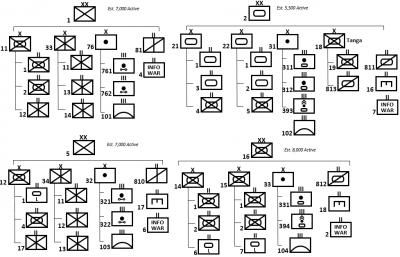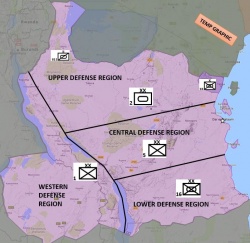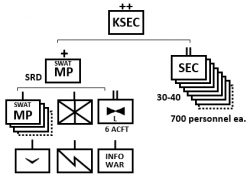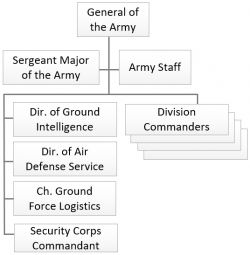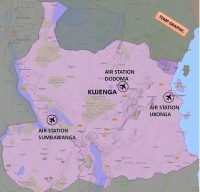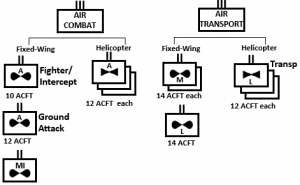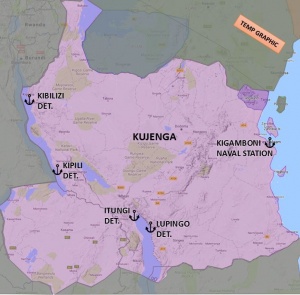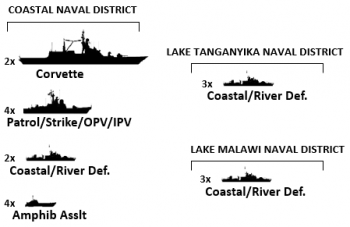Difference between revisions of "Kujenga Armed Service"
Hunt.james (talk | contribs) (Created page with "<div style="float:right;margin-left:15px;">__TOC__</div> <div style="font-size:0.9em; color:#333;"> DATE Africa > Amari > '''{{PAGENAME}}''' ←You are...") |
Hunt.james (talk | contribs) |
||
| Line 116: | Line 116: | ||
===Functional Capabilities=== | ===Functional Capabilities=== | ||
====Command and Control==== | ====Command and Control==== | ||
| − | [[File: | + | [[File:KUJ Army Command Structure.PNG|thumb|250px|right|Kujengan Military Command Structure]]The Kujengan National Army military receives its authority via a civilian control and structure. Its policies and direction are developed based on guidance passed down from the National Defense Council to the General of the Army as its highest ranking official. Command and control (C2) is generally satisfactory, but cynicism and distrust of the Council has created tensions in the higher levels of the military. |
| − | |||
| − | |||
| − | |||
| − | |||
| + | KNA command is somewhat centralized at the national and Defense Region levels. Tactical leaders are generally directed to execute orders and maintain discipline within their units and assigned areas. This leads to situations in which commanders are left to interpret and adapt directives to rapidly evolving local security issues, with mixed results. | ||
| + | In areas where the units are highly segregated, such as the Tanga Garrison, commanders and senior staff are usually from other areas and different tribal, ethnic, or linguistic groups. While intended to maintain control and prevent disaffection in the ranks, this policy has often created more problems than solved. | ||
| + | |||
''(See also [[Chapter 2: Command and Control|TC 7-100.2: Opposing Force Tactics, Chapter 2, Command and Control]])'' | ''(See also [[Chapter 2: Command and Control|TC 7-100.2: Opposing Force Tactics, Chapter 2, Command and Control]])'' | ||
====Maneuver==== | ====Maneuver==== | ||
| − | The | + | The KNA has a capable force, tailored to meet the needs of each Military Defense Region. Maneuver battalions are usually the basic unit that conducts combat operations. Although less common, battalions may also operate as part of a brigade or division-sized task force within their Defense Region as situations dictate. Maneuver units are capable of conducting coordinated offensive operations, but prefer to perform security or containment missions while decisive operations are executed by the designated response forces or indirect fires. |
| − | |||
| − | |||
| − | The | + | The types and structures of units are matched to the widely varied Kujengan terrain and perceived or actual threat conditions. Each of the Defense Regions generally have an established rotation in which units assume guard and response force roles. This facilitates rapid reaction to potential internal crises and provides deterrence. Regions may also rotate units to provide support to other regions or peacekeeping forces. |
| − | |||
====Air Defense==== | ====Air Defense==== | ||
| − | + | Each Military Defense Region's artillery brigade is allocated an air defense regiment. Their primary missions are point defense of key facilities and protection of indirect fire assets. Air defense within maneuver battalions is limited to MANPAD platoons, although the Region commander may allocate additional air defense resources as situations require. In time where the threat of border incursion is perceived as minimal, the Defense Region may station its air defense assets near KNAF locations or training facilities. | |
| − | + | All ground units possess some type of an organic air defense capability to differing degrees, depending on the type and size of the unit. Maneuver and paramilitary forces are trained to use organic systems, such as heavy machine guns, and even some anti-tank guided missiles (ATGMs), in an air defense role. Reserve and border defense elements of the KSEC do not have an organic air defense capability. | |
| − | + | Kujenga’s air defense capabilities are generally not integrated, although the KNA is seeking upgrades to improve their overall effectiveness. | |
''(See also [[Chapter 11: Air Defense|TC 7-100.2: Opposing Force Tactics, Chapter 11, Air Defense]])'' | ''(See also [[Chapter 11: Air Defense|TC 7-100.2: Opposing Force Tactics, Chapter 11, Air Defense]])'' | ||
====INFOWAR==== | ====INFOWAR==== | ||
| − | + | Kujenga leverages its information warfare (INFOWAR) resources and doctrine to maintain strategic awareness and prevent crisis development. The Kujengan Intelligence Service (KIS) is the national-level entity that manages all intelligence resources and analysis – both military and non-military. | |
| + | |||
| + | Kujenga has a basic defensive INFOWAR capability. Its electronic warfare and protection efforts have a long reputation for effectiveness since the significant technical investments of the early 2000’s. Excellent situational awareness and understanding enables each Military Region to effectively manage its force deployments. Most maneuver forces have a dedicated INFOWAR element. Kujengan targeting and unmanned aerial vehicle (UAV) operations are highly dependent on GPS, and consider the potential impact of navigation warfare a critical concern. Maneuver forces routinely train to operate in contested electronic environments. | ||
| − | + | Offensive INFORWAR capabilities are minimal. While all tactical INFOWAR elements have some electronic attack capabilities, they prefer to employ them in preparation for offensive operations. | |
| + | The Kujengan Security Corps' (KSEC) Special Reaction Division (SRD) has a much more advanced INFOWAR capability, with niche Tier 1 systems supporting their high-risk operations. While much of KSEC’s capabilities have been discussed in open source reporting, they may also employ previously unknown COTS systems. | ||
| − | + | Kujenga has taken steps to defend against cyber and information attack, but has room to improve. Operations Security (OPSEC) and human-engineered attacks remain a significant vulnerability. Kujenga does not have an organic offensive cyber capability, although the KIS has allegedly contracted 3rd-party cyber criminals for such operations. The KIS has been publicly accused and implicated in a number of computer attacks throughout the region and worldwide. | |
| − | '' | + | ''See also [[Chapter 7: Information Warfare |TC 7-100.2: Opposing Force Tactics, Chapter 7, Information Warfare ]] and [[Information: Kujenga]]'' |
====RISTA==== | ====RISTA==== | ||
| − | Reconnaissance, intelligence, surveillance, and target acquisition (RISTA) is one of the most | + | Reconnaissance, intelligence, surveillance, and target acquisition (RISTA) in Kujenga is the primary focus of the Kujengan Security Corps (KSEC). Its Special Reaction Division has one of the most advanced technical RISTA capabilities in the region. Most ground RISTA is conducted by static posts or patrols of border elements. Within each Defense Region, maneuver units employ their attached INFOWAR assets. UAVs may be present in the INFOWAR battalions of maneuver units, but budgetary constraints have limited their fielding to mostly the Central Defense Region. |
| − | + | Analysis and management of special RISTA capabilities is conducted at the Defense Region level. The Kujengan Intelligence Service (KIS) will likely support crisis or surge RISTA requirements from its headquarters in Dar es Salaam or by embedding personnel and resources with Region analysts. The KIS will also manage the analysis and utilization of all airborne intelligence assets. | |
| − | + | ====Fire Support==== | |
| + | The Kujengan military views its indirect fire assets as a key military enabler. The KNA relies on field artillery to support its ground forces and devotes significant force structure to ensure a sufficient artillery capability. KNA doctrine leverages fires support to compensate for its mix of ground forces. Direction and allocation of fire is generally coordinated at the Defense Region level, with fire support specialists fielded with each major unit. Artillery has provided effective fire support to both fixing forces and assault forces during counter-guerrilla operations. | ||
| − | + | The Kujengan ground forces contain a mixture of artillery types, including self-propelled guns, rockets and mortars. Field artillery may be supplemented by close air support from fixed- and rotary-wing air assets. While KNA’s fire support systems have aged with few upgrades or enhancements, the KNA has pursued technical upgrades that may increase the accuracy, lethality, and integration of their entire fire support portfolio. System mobility is largely dependent on the type of unit supported. | |
| − | + | Kujenga does not currently possess a viable ballistic missile program. Press reporting over the last decade has accused North Torbia of providing expertise and illegal materiel support to help Kujenga develop a short and medium-range ballistic missile capability. | |
| − | |||
''(See also [[Chapter 9: Indirect Fire Support|TC 7-100.2: Opposing Force Tactics, Chapter 9, Indirect Fire Support]])'' | ''(See also [[Chapter 9: Indirect Fire Support|TC 7-100.2: Opposing Force Tactics, Chapter 9, Indirect Fire Support]])'' | ||
====Protection==== | ====Protection==== | ||
| − | + | Dedicated engineer and protection assets are allocated to Kujengan ground forces based on the particular requirements of their Defense Region. Each Region has roughly a battalion-sized engineer element. These forces’ mission is to protect key facilities, support border counter-mobility efforts, and ensure maneuver forces’ mobility and survivability. | |
| + | Engineer elements are slightly more capable than the overall force, but still suffer from endemic leadership and readiness challenges. They gained experience through peacekeeping and disaster relief deployments. | ||
| + | |||
| + | Landmines from previous conflicts are periodically discovered, usually by farmers. These not only pose a hazard to farmers and unwitting travelers, but may be sold to guerrillas or other extremists for re-use. KNA engineer and infantry elements are involved in demining efforts in the remote northwestern territory and in places along the Amari border. | ||
''(See also [[Chapter 12: Engineer Support|TC 7-100.2: Opposing Force Tactics, Chapter 12, Engineer Support]])'' | ''(See also [[Chapter 12: Engineer Support|TC 7-100.2: Opposing Force Tactics, Chapter 12, Engineer Support]])'' | ||
====Logistics==== | ====Logistics==== | ||
| − | + | Kujenga enjoys a stable and well-structured military logistics system. Materiel is received from the various points of entry, then pushed to the Defense Region depots for onward supply. This programmed distribution model has proved relatively successful with few exceptions. In contrast, Kujenga’s deployment logistics have experienced significant challenges. This is partly due to corruption and graft and Kujenga’s main ports. | |
| + | |||
| + | ====CBRNE==== | ||
| + | Kujenga does not have a confirmed offensive chemical warfare capability, nor is its use a part of their doctrine. All personnel receive a basic chemical attack reaction and first aid training. Emergency responders in all cities have more advanced capabilities for mass casualty events resulting from chemical or biological attack. | ||
| − | + | In addition to the alleged transfer of [[North Torbia|North Torbian]] ballistic missile technology, [[South Torbia]]’s UN testimony in 2012 added that North Torbia was also offering chemical weapons assistance to unspecified Kujengan defense personnel in exchange for access to natural resources. This is unconfirmed. | |
| − | + | The 2013 joint statement of the Chemical Society of Kujenga (CSK) led the Kujengan government to reaffirm its call to "strengthen regulatory and legal frameworks in order to reinforce chemical security in the country in order to reduce global chemical threat and prevent terrorist access to chemical weapons." | |
| − | |||
| − | == | + | ==Kujengan National Air Force (KNAF)== |
| − | The | + | The Kujengan National Air Force (KNAF) is capable of supporting limited ground support and defensive counter-air (DCA) operations. Its missions include combat air patrol, close air support (CAS), strike, and a heavy emphasis on air transport. While air operations are integrated with Kujengan ground force activities, air assets are not generally aligned with a particular Defense Region. |
===Air Force Size and Structure=== | ===Air Force Size and Structure=== | ||
| − | [[File: | + | [[File:KNAF Disposition.JPG|200px|thumb|right|KNAF Disposition]]The KNAF operates approximately 74 fixed-wing aircraft and 92 rotary-wing aircraft. KNAF operates almost exclusively from air bases in Dodoma, Sumbawanga, and its primary base near the capitol at Ukonga. These are roughly co-located with large civilian airports and may share some facilities and resources, such as runways and bulk-purchased fuel. The National Defense Council may authorize use of civilian airfields for military purposes under a declared civil emergency, though this would likely not be well-received by the Kujengan public. |
===Air Force Doctrine and Tactics=== | ===Air Force Doctrine and Tactics=== | ||
| − | The | + | The KNAF’s primary missions are the defense of Kujengan airspace and responding to potential or nascent internal crises. Air assets may be used to transport both military and civilian supplies to remote areas. Due to Kujenga’s relatively large territory, ground attack aircraft may be used during crisis reduction situations as a disruption element until ground forces can respond. Kujengan pilots have been accused of violating the international borders – particularly when supporting naval operations against maritime piracy. |
===Air Force Weapons and Equipment=== | ===Air Force Weapons and Equipment=== | ||
| − | + | KNAF’s aircraft inventory is generally Tier 2 to Tier 3, technology dating from 25 to 40 years ago. Aircraft converted for intelligence purposes may have been fitted with niche Tier 2, or in some cases, Tier 1 systems. The Kujengan air force has a limited capability for 24-hour operations and may be hindered in severe weather. The equipment is generally [[Donovia|Donovian]] in origin, with some possible [[Olvana|Olvana]] variants. | |
| − | [[File: | + | [[File:KUJ KNAF FS.PNG|300px|thumb|right|KNAF Force Structure]] |
'''Air Combat Group:''' | '''Air Combat Group:''' | ||
*Fighter/Intercept SQDN | *Fighter/Intercept SQDN | ||
*Ground Attack SQDN | *Ground Attack SQDN | ||
| − | |||
*Intelligence and Surveillance SQDN | *Intelligence and Surveillance SQDN | ||
| + | *3x Attack Helicopter SQDNs | ||
'''Air Transport Group''' | '''Air Transport Group''' | ||
| − | *Medium Air Transport SQDNs | + | *2x Medium Air Transport SQDNs |
| − | * | + | *Light Air Transport SQDNs |
| − | |||
*3x Light Helicopter Transport SQDNs | *3x Light Helicopter Transport SQDNs | ||
===Air Force Training and Readiness=== | ===Air Force Training and Readiness=== | ||
| − | + | KNAF aircraft are kept at a relatively high state of repair and readiness, despite their age. A disciplined and well-funded maintenance program coupled with contracted technical personnel have kept its aircraft operating well beyond their normal operating lifespan. Pilots receive training from a variety of sources, including contracted Donovian trainers. Flight hours, however, are at a premium, and pilot proficiency suffers as a result. During times of relative peace, training missions and patrolling may be limited to reduce operating costs. | |
| − | |||
| − | |||
| − | |||
| − | |||
| − | The | + | ==Kujengan National Navy (KNAV)== |
| + | The Kujengan National Navy (KNAV)is responsible for maritime security along Kujenga’s coastline and on inland bodies. It also possesses a moderate force projection capability. KNAV doctrine centers on defense and security, with a heavy emphasis on securing the coastal and inland bodies of water and protecting commercial traffic and resource shipping from smugglers and pirates. | ||
| − | + | KNAV missions include: | |
| − | * | + | *Coastal patrol |
*Lake and inland waterway security | *Lake and inland waterway security | ||
| − | * | + | *Peacekeeping support |
| − | * | + | *Maritime crime, smuggling, and piracy suppression |
| − | * | + | *Humanitarian assistance and disaster relief support |
| − | * | + | *Environmental protection |
| − | *Maritime | + | *Maritime search and rescue |
| − | + | *Ministry of Fisheries assistance | |
| − | * | + | *Offshore resource protection |
| − | * | ||
| + | ===Navy Size and Structure=== | ||
| + | [[File:KNAV Disposition.JPG|300px|thumb|right|Amari Naval Disposition]]KNAV divides maritime security responsibilities into three control districts: | ||
| − | + | '''Coastal Naval District.''' This is the largest KNAV district. It has responsibility for all maritime operations along Kujenga’s Indian Ocean coast and territorial waters, including the Zanzibar and Mafia Islands. KNAV maintains its headquarters at the Kigamboni Naval Station near Dar es Salaam. | |
| − | |||
| − | ''' | + | '''Lake Tanganyika Naval District.''' This district is responsible for maritime operations within Kujengan territory on Lake Tanganyika and Lake Rukwa. It maintains permanent detachments at Kiblizi and Kipli. Operations on Lake Rukwa include local security and environmental patrol, usually conducted with contracted small vessels of various types. There is not a permanent KANV presence on inland water in the Kasama region, although spot patrols are conducted on a varying schedule. |
| − | ''' | + | '''Lake Malawi Naval District.''' This district is responsible for maritime operations within Kujengan territory on Lake Malawi. It maintains permanent detachments at Itungi and Lupingo. |
===Navy Weapons and Equipment=== | ===Navy Weapons and Equipment=== | ||
| − | + | KNAV’s inventory is largely Tier 2 and 3 equipment from Donovia and Olvana. Maritime systems focus on coastal defense and domestic security operations. KNAV coastal vessels can operate in all seas and can successfully conduct 24-hour operations, while their inland counterparts may have limitations – both technical and policy-based. KNAV possesses 18 surface craft and manages a small fleet of vessels contracted or on retainer to supplement capabilities or provide surge capacity. | |
| − | |||
| − | |||
| − | |||
| − | |||
| − | |||
| − | |||
| − | [[File: | + | [[File:KNAV Force Structure.PNG|350px|thumb|right|KNAV Force Structure]] |
| − | + | KNAV Inventory: | |
| − | |||
*2x Corvettes | *2x Corvettes | ||
| − | * | + | *4x Patrol/Strike/OPV/IPV |
| − | * | + | *8x Coastal/River defense |
| − | |||
| − | |||
*4x Amphibious assault | *4x Amphibious assault | ||
| − | * | + | *Multiple small commercial vessels (contracted/on retainer) |
===Navy Training and Readiness=== | ===Navy Training and Readiness=== | ||
| − | + | Over the last decade, KNAV has suffered from the same command challenges as Kujenga's other services. Budget allocations are more often justified for internal security than national defense. Despite setbacks, KNAV maintains its available resources at a decent state of operational readiness. KNAV’s maritime readiness is estimated to be at approximately 65-70%. | |
Revision as of 15:28, 9 February 2018
Contents
- 1 Kujengan National Command Authority
- 2 National Strategic Goals
- 3 Kujengan National Army (KNA)
- 4 Kujengan National Air Force (KNAF)
- 5 Kujengan National Navy (KNAV)
DATE Africa > Amari > Kujenga Armed Service ←You are here
The Kujenga Armed Service (KAS) is the state military of Republic of Kujenga. It emerged from a somewhat turbulent past and a range of internal security challenges. Kujenga’s military relations with its neighbors are relatively stable, although border security issues despite ongoing tensions in the Tanga region increasing the risk of regional conflict. The KAS consists of the Kujengan Army, Kujengan National Air Force (KNAF), Kujengan National Navy (KNAV), and Security Corps.
Kujenga's primary internal security concerns include Tangan separatists, violent bush militias in the central mountains, and the brutal "Army of Justice and Purity" guerrillas in the Kasama region. External threats include border incursions by presumed Amari paramilitaries and cross-border smuggling.
The KAS faces challenges due to the demographically fractured history of the area that is now Kujenga. Widely varied levels of professionalism and equipment reflect the piecemeal nature of the KAS’s development. KAS forces have a mixed reputation among the populace and in the region. While they are generally considered professional, there have been incidents of unit commanders becoming hostile towards the people in remote areas. Some units had to be re-assigned due to religious and tribal conflicts. Along with efforts to increase its presence on the international stage, Kujenga participates in both international and regional peacekeeping forces. While in these roles, Kujengan forces established a dubious reputation when operating with other militaries. Over the last ten years, however, multi-national exercises and real-world deployments improved KAS’s overall combat readiness and capabilities. Kujenga cooperated with various non-governmental organizations to gain assistance during various past crises. The most prominent organizations helped Kujenga with its internally displaced persons (IDP), driven from their homes by militia and guerrilla violence in its southwest Kasama region. The Kujengan government pledged support for basing of refugee settlements within its borders, but these did not develop.
While the KAS are officially integrated, unit-level segregation remains commonplace. Most units are manned by people from the geographic area that their unit operates in, though their commanders are likely from elsewhere. This approach is mostly effective, though tensions in the Tanga region remain high. Women can serve in almost all roles, though most are assigned to support functions. All Kujengans receive a compulsory military familiarization training as part of the final year of studies, which serves to identify potentially talented personnel for additional training or assignment. Defense spending and percentage of GDP included over the last five years averaged 2.7% of GDP. (Figures from CIA World Factbook.)
| Amari | Ziwa | Nyumba |
|---|---|---|
|
|
|
Kujengan National Command Authority
The Kujengan National Defense Council (KNDC) exercises overall control of the application of all instruments of national power. The KNDC also plans and executes the national security strategy. The KNDC includes the Defense Minister, Deputy Prime Minister, armed service chiefs, and the Chief of the Intelligence Division. The Prime Minister may appoint Special Advisors to the KNDC as he deems appropriate and necessary. Each armed service chief is the senior officer of their respective service. The Commandant of the Kujengan Security Corps is subordinate to the General of the Army and not a member of the KNDC.National Strategic Goals
The National Defense Council prepares and disseminates statements relating to the direction and scope of Kujengan military strategy. Kujenga’s primary strategic goals include maintaining internal security and defending territorial integrity against border incursions by its neighbors. Kujenga states that it reserves the right to defend its borders and territorial claims from aggression. Additional statements extend their perception of rights to include preemptive strikes against invasion or to prevent insurrections.
Examples of strategic goals supplements include:
- Enforce territorial integrity and maintain border security
- Subdue insurgent groups and militia groups that threaten internal security and inhibit free trade and tourism.
- Enhance government and military control of the Kasama region
Kujengan National Army (KNA)
Kujenga fields a competent ground force, capable of conducting a wide range of coordinated operations. KNA active duty ground forces number approximately 27,500 personnel, including those paramilitary groups on active duty. Reserve forces number approximately 24,500 personnel, but can vary widely in both in size and capability. The KNA is organized into Defense Regions, each region with a division-sized force. Allocated forces are tailored to each region’s specific requirements.
The KNA’s primary roles are ensuring internal security and maintaining the integrity of the Kujengan borders and territories. The KNA guards against external aggression and protects the Kujengan people and government against violent extremists.
The KNA occasionally deploys selected elements in support of regional and international peacekeeping efforts; peacekeeping force participation develops military skills and supports diplomatic agreements. Over the last ten years, the KNA deployed forces to western Africa in support of humanitarian and medical crises, and to Iraq as part of a US-led force rotation.
Doctrine and Tactics
Kujengan military doctrine focuses on stabilizing security while maintaining the capacity to mount offensive operations to secure order and provide deterrence. Kujenga’s practical doctrine developed from its near constant internal and borders conflicts.
Rather than training together for joint combined arms operations, the KAS prefers to train for stability operations, both internal and on the border. These operations include raids and other offensive actions with up to battalion-sized elements. Brigade-sized operations have been observed but are rare; participating forces will generally be from the same Defense Region. Inter-regional combined operations are also rare, but are exercised at annual events at the Kujenga Military Academy.
Once threats are engaged, units conduct decisive operations as part of a strike force. Defense Regions often rotate assigned units through a readiness progression of reaction and strike roles to balance capabilities.
The KSEC and its elite Special Reaction Division respond to incidents that don’t rise to conventional forces’ reaction level, or to particularly high-risk or sensitive situations. These forces may also coordinate local resources and non-activated reservists to assist in reducing crisis conditions.
The Kujengan military has demonstrated the ability to adapt to changing situations – particularly within Defense Regions. THE KAS is capable when responding to perceived crises, but follow-on strategies are often less effective. Based on the variety of military trainers that have passed through Kujenga, they will likely use Western tactical control measures, including pre-determined assembly areas, axes-of-advance, checkpoints, and attack lines.
Composition and Disposition
Maneuver battalions are Kujenga’s basic combined arms unit, with most being able to operate semi-independently. KNA brigades can conduct combat operations with their organic organization, or they can be or task-organized within their assigned Military Regions. Previous KNA leadership made claims of division-level operations, but these have not been exercised in years. The KNA’s divisions and subordinate elements are assigned to Military Defense Regions to ensure maximum responsiveness to potential local crises. Regional outlines, however, have proven somewhat problematic due to apparently arbitrary placement by previous administrations. Most units are manned by soldiers hailing from the assigned area, though low-density skills are often outsourced from a national pool. The officer corps at battalion and above has no geographic or demographic assignment preference. This creates some friction in the Tanga Garrison, where the senior officers’ demographic differs significantly from their forces.Primary Formations:
 1st Division (Western Region)
1st Division (Western Region) 2nd Division (Upper Region)
2nd Division (Upper Region) 5th Division (Central Region)
5th Division (Central Region) 16th Division (Lower Region)
16th Division (Lower Region)
1st Division. Based near Mbeya in the Western Military Region. Responsible for maintaining order in the Kasama region and along the western border. Traditionally has a significant augmentation from the Security Corps. Routinely engages guerrilla forces of the Army of Justice and Purity (AJP), as well as protecting against banditry and diminishing militia violence.
2nd Division. With brigades in Dodoma and Tabora in the Upper Military Region, the 2nd Division is responsible for maintaining internal security and guarding against potential Amarian and Ziwan aggression. There is also a dedicated garrison stationed in the Tanga region due to the tense security situation. The Kujengan Security Corps’ Special Reaction Division shares facilities with the brigade near Air Station Dodoma.
5th Division. The 5th Division is dispersed through the Central Military Region and responsible for maintaining security around Dar es Salaam and the region surrounding the Udzungwa mountain range. Deployed to suppress banditry and the rampant militia and gang violence. Elements may also support maritime security in cooperation with the Navy.
16th Division. The 16th Division is arrayed across Kujenga’s southern border in the Lower Military Region with garrisons near Songea, Masasi, and Mtwara. Responsible for maintaining internal security and guarding against potential border incursions from its southern neighbor. Prepared to redeploy in support of operations to contain guerrilla violence of the western region. Elements may also support maritime security in cooperation with the Navy.
Paramilitary Forces
Kujengan Security Corps (KSEC). The KSEC is the state paramilitary security force of Kujenga. They are subordinate to the Kujengan National Army, although elements may be attached to support the Kujengan Intelligence Service. KSEC is a well-trained, professional, and disciplined force. It is capable of deploying in support of rapid strike operations, riot control, and crisis assistance. Elements not actively engaged may augment KNA border security operations.
The KSEC’s reported 30,000 personnel are organized into 30-40 "squadrons" of approximately 700 personnel each. The number of squadrons and the actual manning levels can vary substantially based on availability of personnel and budgetary constraints. Personnel receiving compulsory military familiarization are often assigned to one of these units. In addition to small arms, these units employ number of trucks and utility vehicles. Units aligned with inland maritime support missions may employ small rigid-hulled or inflatable watercraft.
Special Reaction Division (SRD). The SRD is Kujenga’s elite paramilitary response unit. Most are veterans of the KNA who received additional training from corporate security companies from the UK and Israel. They are tasked with VIP security, raids, and other high-risk operations. When not engaged in its primary missions, SRD personnel support internal security requirements of the KNA and the Kujenga Intelligence Service.
The SRD has its approximately 5,000 personnel aligned with the Military Districts of the KNA. Any of these elements may be re-tasked to meet specific requirements. They have more robust and modern capabilities than any of Kujenga’s other forces. In addition to small arms, the SRD employs Armored Personnel Carriers (APC), limited heavy weapons, and advanced communications and intelligence capabilities. They also employ dedicated light fixed- and rotary-wing air assets, as well as state of the art unmanned systems. The BGC’s primary roles are border control operations and combating crime cross-border trafficking and other transient criminal activities. They are primarily utilized to augment police in elevated-risk inspections at customs stations and to supplement border infantry forces. Soldiers leaving active duty with regular units often transfer to the KSEC rather than to the inactive reserve rolls.
(See also TC 7-100.2: Opposing Force Tactics, Chapter 15, Special Purpose Forces and Commandos.)
Training and Readiness
The military draws most of its personnel from the Kujengan compulsory training programs. All Kujengans receive compulsory military familiarization training as part of their final year of studies (usually ages 17-19), which serves to identify potential personnel for additional training or assignment. Training consists of a basic military familiarization and training course, with follow-on special skill training based on aptitude and operational requirements. Personnel that complete the compulsory training incur an 8-year recall obligation, reduced to four years if the individual serves on active duty. Exemptions to this recall obligation include medical, educational, or “special public service.” The latter has been criticized for being merely a payoff to public officials to escape obligations. Those that are physically or mentally unable to perform the required training are instead trained to their level of ability, then incorporated into roles their abilities allow. All personnel that have completed training are aligned with elements of the active forces or the Kujengan Security Corps.
Military training, both compulsory and for the active component, are conducted at training sites maintained and operated by each Defense Region. Higher-level or specialized training may be conducted at the Kujenga Military Academy, approximately 18 kilometers west of Morogoro in the Central Defense Region. Despite a thorough basic military education, advanced and technical skills are typically taught on the job by more experienced personnel.
The mixed professionalism of the Kujengan military has created problems throughout its sometimes turbulent history. Though the force is officially integrated, tribal and linguistic segregation at the unit level is still common. Tensions have flared in the more remote units, which often have commanders or senior staff of different backgrounds than their subordinates. Most of the Kujengan military operates at approximately 65-70% readiness.
Kujenga’s Defense Regions conduct training and readiness drills with unit within their designated areas. Most units participate in either cross-region support drills or force projection exercises. Due to budget constraints, some regions opt to enhance readiness by providing forces to sponsored peacekeeping operations. This has sometimes led to consistency and professionalism challenges as units operate outside of their training cohorts.
Reserve personnel participate in rotational assignments with their aligned active component throughout the year. The skill and overall quality of the reserve personnel is mixed. Some units prioritize reservist training, while some actively resist their assigned reservists and relegate them to the most unpleasant duties.
Division of Reserve Forces. Kujenga does not have distinct reserve units. Rather, reserve personnel and resources are managed by compulsory training programs under the Division of Reserve Forces. Additional materiel resources needed for surge capabilities are maintained with the aligned elements.
Weapons and Equipment
The weapons and equipment of the Kujengan National Army are mostly Tier 3. The 2nd Division (in the Upper Defense Region) has a partial allocation of Tier 2 capabilities due to the Kujengan perception of threats from its northern neighbors, Amari and Ziwa. The Security Corps' Special Reaction Division has Tier 2 and niche Tier 1 capabilities. Many of these are COTS communications and technical acquisitions.
The Kujengan inventory is primarily Donovian – acquired through past military sales agreements and advisors mixing Donovian, Olvanese, and South African equipment. The KNA’s allocation of equipment is based largely on local terrain and threat assessments. The forces in each Defense Region are generally capable of operating throughout the terrain in their assigned area. While most ground forces can conduct both day and night operations, some of the outlying elements may have limited night time capabilities.
Functional Capabilities
Command and Control
The Kujengan National Army military receives its authority via a civilian control and structure. Its policies and direction are developed based on guidance passed down from the National Defense Council to the General of the Army as its highest ranking official. Command and control (C2) is generally satisfactory, but cynicism and distrust of the Council has created tensions in the higher levels of the military.KNA command is somewhat centralized at the national and Defense Region levels. Tactical leaders are generally directed to execute orders and maintain discipline within their units and assigned areas. This leads to situations in which commanders are left to interpret and adapt directives to rapidly evolving local security issues, with mixed results. In areas where the units are highly segregated, such as the Tanga Garrison, commanders and senior staff are usually from other areas and different tribal, ethnic, or linguistic groups. While intended to maintain control and prevent disaffection in the ranks, this policy has often created more problems than solved.
(See also TC 7-100.2: Opposing Force Tactics, Chapter 2, Command and Control)
Maneuver
The KNA has a capable force, tailored to meet the needs of each Military Defense Region. Maneuver battalions are usually the basic unit that conducts combat operations. Although less common, battalions may also operate as part of a brigade or division-sized task force within their Defense Region as situations dictate. Maneuver units are capable of conducting coordinated offensive operations, but prefer to perform security or containment missions while decisive operations are executed by the designated response forces or indirect fires.
The types and structures of units are matched to the widely varied Kujengan terrain and perceived or actual threat conditions. Each of the Defense Regions generally have an established rotation in which units assume guard and response force roles. This facilitates rapid reaction to potential internal crises and provides deterrence. Regions may also rotate units to provide support to other regions or peacekeeping forces.
Air Defense
Each Military Defense Region's artillery brigade is allocated an air defense regiment. Their primary missions are point defense of key facilities and protection of indirect fire assets. Air defense within maneuver battalions is limited to MANPAD platoons, although the Region commander may allocate additional air defense resources as situations require. In time where the threat of border incursion is perceived as minimal, the Defense Region may station its air defense assets near KNAF locations or training facilities.
All ground units possess some type of an organic air defense capability to differing degrees, depending on the type and size of the unit. Maneuver and paramilitary forces are trained to use organic systems, such as heavy machine guns, and even some anti-tank guided missiles (ATGMs), in an air defense role. Reserve and border defense elements of the KSEC do not have an organic air defense capability.
Kujenga’s air defense capabilities are generally not integrated, although the KNA is seeking upgrades to improve their overall effectiveness.
(See also TC 7-100.2: Opposing Force Tactics, Chapter 11, Air Defense)
INFOWAR
Kujenga leverages its information warfare (INFOWAR) resources and doctrine to maintain strategic awareness and prevent crisis development. The Kujengan Intelligence Service (KIS) is the national-level entity that manages all intelligence resources and analysis – both military and non-military.
Kujenga has a basic defensive INFOWAR capability. Its electronic warfare and protection efforts have a long reputation for effectiveness since the significant technical investments of the early 2000’s. Excellent situational awareness and understanding enables each Military Region to effectively manage its force deployments. Most maneuver forces have a dedicated INFOWAR element. Kujengan targeting and unmanned aerial vehicle (UAV) operations are highly dependent on GPS, and consider the potential impact of navigation warfare a critical concern. Maneuver forces routinely train to operate in contested electronic environments.
Offensive INFORWAR capabilities are minimal. While all tactical INFOWAR elements have some electronic attack capabilities, they prefer to employ them in preparation for offensive operations. The Kujengan Security Corps' (KSEC) Special Reaction Division (SRD) has a much more advanced INFOWAR capability, with niche Tier 1 systems supporting their high-risk operations. While much of KSEC’s capabilities have been discussed in open source reporting, they may also employ previously unknown COTS systems.
Kujenga has taken steps to defend against cyber and information attack, but has room to improve. Operations Security (OPSEC) and human-engineered attacks remain a significant vulnerability. Kujenga does not have an organic offensive cyber capability, although the KIS has allegedly contracted 3rd-party cyber criminals for such operations. The KIS has been publicly accused and implicated in a number of computer attacks throughout the region and worldwide.
See also TC 7-100.2: Opposing Force Tactics, Chapter 7, Information Warfare and Information: Kujenga
RISTA
Reconnaissance, intelligence, surveillance, and target acquisition (RISTA) in Kujenga is the primary focus of the Kujengan Security Corps (KSEC). Its Special Reaction Division has one of the most advanced technical RISTA capabilities in the region. Most ground RISTA is conducted by static posts or patrols of border elements. Within each Defense Region, maneuver units employ their attached INFOWAR assets. UAVs may be present in the INFOWAR battalions of maneuver units, but budgetary constraints have limited their fielding to mostly the Central Defense Region.
Analysis and management of special RISTA capabilities is conducted at the Defense Region level. The Kujengan Intelligence Service (KIS) will likely support crisis or surge RISTA requirements from its headquarters in Dar es Salaam or by embedding personnel and resources with Region analysts. The KIS will also manage the analysis and utilization of all airborne intelligence assets.
Fire Support
The Kujengan military views its indirect fire assets as a key military enabler. The KNA relies on field artillery to support its ground forces and devotes significant force structure to ensure a sufficient artillery capability. KNA doctrine leverages fires support to compensate for its mix of ground forces. Direction and allocation of fire is generally coordinated at the Defense Region level, with fire support specialists fielded with each major unit. Artillery has provided effective fire support to both fixing forces and assault forces during counter-guerrilla operations.
The Kujengan ground forces contain a mixture of artillery types, including self-propelled guns, rockets and mortars. Field artillery may be supplemented by close air support from fixed- and rotary-wing air assets. While KNA’s fire support systems have aged with few upgrades or enhancements, the KNA has pursued technical upgrades that may increase the accuracy, lethality, and integration of their entire fire support portfolio. System mobility is largely dependent on the type of unit supported.
Kujenga does not currently possess a viable ballistic missile program. Press reporting over the last decade has accused North Torbia of providing expertise and illegal materiel support to help Kujenga develop a short and medium-range ballistic missile capability.
(See also TC 7-100.2: Opposing Force Tactics, Chapter 9, Indirect Fire Support)
Protection
Dedicated engineer and protection assets are allocated to Kujengan ground forces based on the particular requirements of their Defense Region. Each Region has roughly a battalion-sized engineer element. These forces’ mission is to protect key facilities, support border counter-mobility efforts, and ensure maneuver forces’ mobility and survivability. Engineer elements are slightly more capable than the overall force, but still suffer from endemic leadership and readiness challenges. They gained experience through peacekeeping and disaster relief deployments.
Landmines from previous conflicts are periodically discovered, usually by farmers. These not only pose a hazard to farmers and unwitting travelers, but may be sold to guerrillas or other extremists for re-use. KNA engineer and infantry elements are involved in demining efforts in the remote northwestern territory and in places along the Amari border.
(See also TC 7-100.2: Opposing Force Tactics, Chapter 12, Engineer Support)
Logistics
Kujenga enjoys a stable and well-structured military logistics system. Materiel is received from the various points of entry, then pushed to the Defense Region depots for onward supply. This programmed distribution model has proved relatively successful with few exceptions. In contrast, Kujenga’s deployment logistics have experienced significant challenges. This is partly due to corruption and graft and Kujenga’s main ports.
CBRNE
Kujenga does not have a confirmed offensive chemical warfare capability, nor is its use a part of their doctrine. All personnel receive a basic chemical attack reaction and first aid training. Emergency responders in all cities have more advanced capabilities for mass casualty events resulting from chemical or biological attack.
In addition to the alleged transfer of North Torbian ballistic missile technology, South Torbia’s UN testimony in 2012 added that North Torbia was also offering chemical weapons assistance to unspecified Kujengan defense personnel in exchange for access to natural resources. This is unconfirmed.
The 2013 joint statement of the Chemical Society of Kujenga (CSK) led the Kujengan government to reaffirm its call to "strengthen regulatory and legal frameworks in order to reinforce chemical security in the country in order to reduce global chemical threat and prevent terrorist access to chemical weapons."
Kujengan National Air Force (KNAF)
The Kujengan National Air Force (KNAF) is capable of supporting limited ground support and defensive counter-air (DCA) operations. Its missions include combat air patrol, close air support (CAS), strike, and a heavy emphasis on air transport. While air operations are integrated with Kujengan ground force activities, air assets are not generally aligned with a particular Defense Region.
Air Force Size and Structure
The KNAF operates approximately 74 fixed-wing aircraft and 92 rotary-wing aircraft. KNAF operates almost exclusively from air bases in Dodoma, Sumbawanga, and its primary base near the capitol at Ukonga. These are roughly co-located with large civilian airports and may share some facilities and resources, such as runways and bulk-purchased fuel. The National Defense Council may authorize use of civilian airfields for military purposes under a declared civil emergency, though this would likely not be well-received by the Kujengan public.Air Force Doctrine and Tactics
The KNAF’s primary missions are the defense of Kujengan airspace and responding to potential or nascent internal crises. Air assets may be used to transport both military and civilian supplies to remote areas. Due to Kujenga’s relatively large territory, ground attack aircraft may be used during crisis reduction situations as a disruption element until ground forces can respond. Kujengan pilots have been accused of violating the international borders – particularly when supporting naval operations against maritime piracy.
Air Force Weapons and Equipment
KNAF’s aircraft inventory is generally Tier 2 to Tier 3, technology dating from 25 to 40 years ago. Aircraft converted for intelligence purposes may have been fitted with niche Tier 2, or in some cases, Tier 1 systems. The Kujengan air force has a limited capability for 24-hour operations and may be hindered in severe weather. The equipment is generally Donovian in origin, with some possible Olvana variants.
Air Combat Group:
- Fighter/Intercept SQDN
- Ground Attack SQDN
- Intelligence and Surveillance SQDN
- 3x Attack Helicopter SQDNs
Air Transport Group
- 2x Medium Air Transport SQDNs
- Light Air Transport SQDNs
- 3x Light Helicopter Transport SQDNs
Air Force Training and Readiness
KNAF aircraft are kept at a relatively high state of repair and readiness, despite their age. A disciplined and well-funded maintenance program coupled with contracted technical personnel have kept its aircraft operating well beyond their normal operating lifespan. Pilots receive training from a variety of sources, including contracted Donovian trainers. Flight hours, however, are at a premium, and pilot proficiency suffers as a result. During times of relative peace, training missions and patrolling may be limited to reduce operating costs.
The Kujengan National Navy (KNAV)is responsible for maritime security along Kujenga’s coastline and on inland bodies. It also possesses a moderate force projection capability. KNAV doctrine centers on defense and security, with a heavy emphasis on securing the coastal and inland bodies of water and protecting commercial traffic and resource shipping from smugglers and pirates.
KNAV missions include:
- Coastal patrol
- Lake and inland waterway security
- Peacekeeping support
- Maritime crime, smuggling, and piracy suppression
- Humanitarian assistance and disaster relief support
- Environmental protection
- Maritime search and rescue
- Ministry of Fisheries assistance
- Offshore resource protection
KNAV divides maritime security responsibilities into three control districts:
Coastal Naval District. This is the largest KNAV district. It has responsibility for all maritime operations along Kujenga’s Indian Ocean coast and territorial waters, including the Zanzibar and Mafia Islands. KNAV maintains its headquarters at the Kigamboni Naval Station near Dar es Salaam.
Lake Tanganyika Naval District. This district is responsible for maritime operations within Kujengan territory on Lake Tanganyika and Lake Rukwa. It maintains permanent detachments at Kiblizi and Kipli. Operations on Lake Rukwa include local security and environmental patrol, usually conducted with contracted small vessels of various types. There is not a permanent KANV presence on inland water in the Kasama region, although spot patrols are conducted on a varying schedule.
Lake Malawi Naval District. This district is responsible for maritime operations within Kujengan territory on Lake Malawi. It maintains permanent detachments at Itungi and Lupingo.
KNAV’s inventory is largely Tier 2 and 3 equipment from Donovia and Olvana. Maritime systems focus on coastal defense and domestic security operations. KNAV coastal vessels can operate in all seas and can successfully conduct 24-hour operations, while their inland counterparts may have limitations – both technical and policy-based. KNAV possesses 18 surface craft and manages a small fleet of vessels contracted or on retainer to supplement capabilities or provide surge capacity.
KNAV Inventory:
- 2x Corvettes
- 4x Patrol/Strike/OPV/IPV
- 8x Coastal/River defense
- 4x Amphibious assault
- Multiple small commercial vessels (contracted/on retainer)
Over the last decade, KNAV has suffered from the same command challenges as Kujenga's other services. Budget allocations are more often justified for internal security than national defense. Despite setbacks, KNAV maintains its available resources at a decent state of operational readiness. KNAV’s maritime readiness is estimated to be at approximately 65-70%.
| DATE Africa Quick Links . | |
|---|---|
| Amari | Political • Military • Economic • Social • Information • Infrastructure • Physical Environment • Time |
| Kujenga | Political • Military • Economic • Social • Information • Infrastructure • Physical Environment • Time |
| Nyumba | Political • Military • Economic • Social • Information • Infrastructure • Physical Environment • Time |
| Ziwa | Political • Military • Economic • Social • Information • Infrastructure • Physical Environment • Time |
| Other | Non-State Threat Actors and Conditions • Criminal Activity • DATE Map References • Using The DATE |


